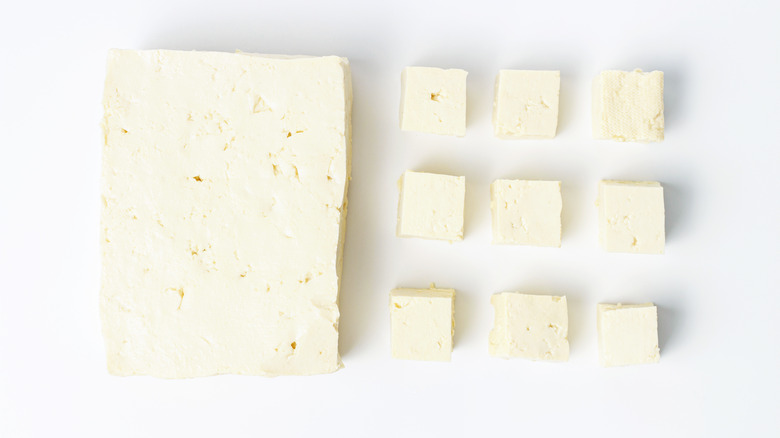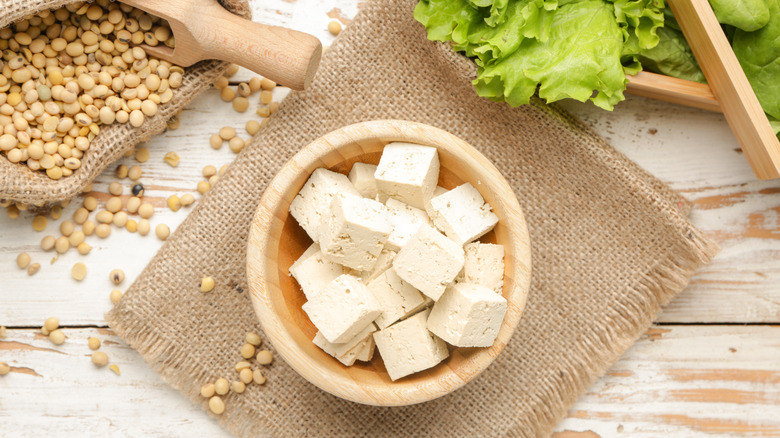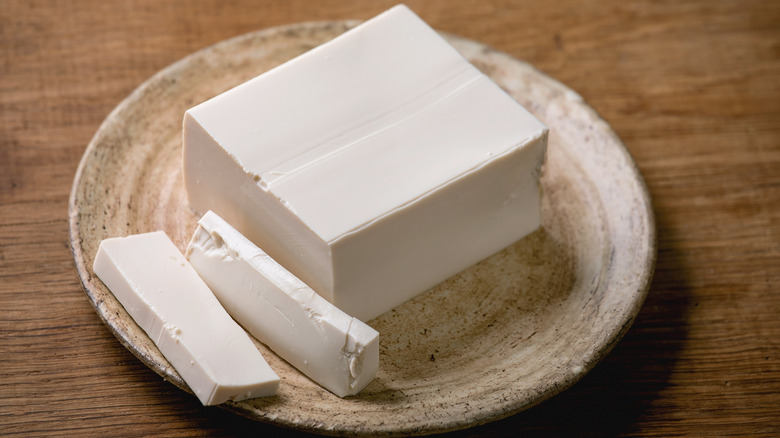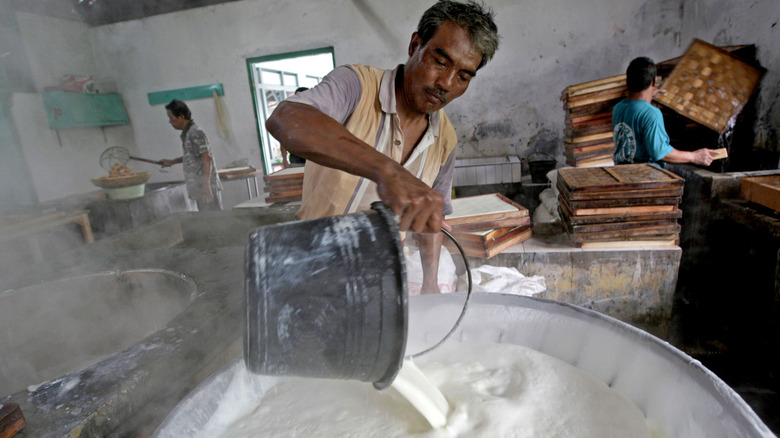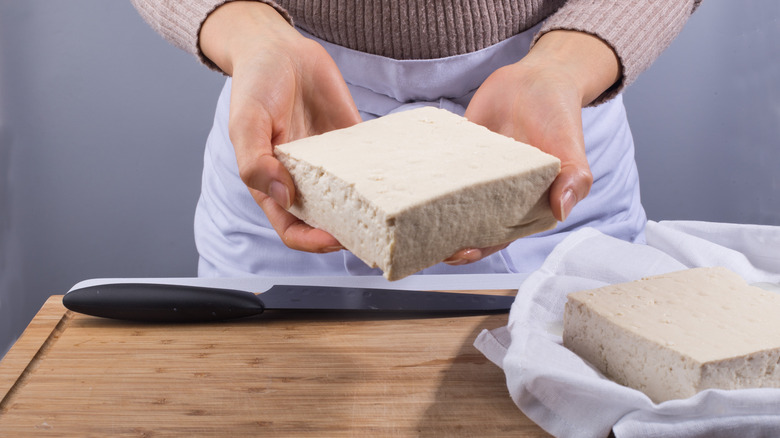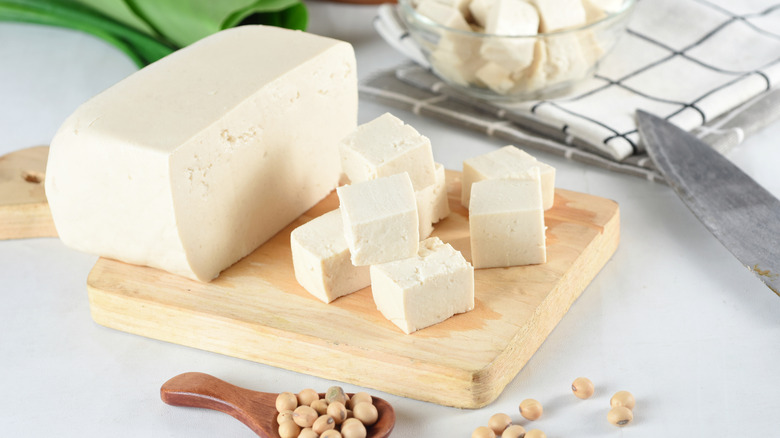What Is Bean Curd And Is It Nutritious?
What once began as a staple of Asian cuisine, bean curd (aka tofu) has continued to grow in popularity and ubiquity, especially as more and more people begin to eschew animal products from their diets. Bean curd is versatile, malleable, and adapts to almost any flavor imaginable — it is an excellent blank canvas that is seamlessly imbued by the ingredients it is served with. It can be cooked in a multitude of ways and is delicious regardless of the preparation. If you are hesitant about cooking with bean curd — or think it is only an option for you to order when out to eat — read ahead to learn more about its history, its uses, and the easiest (and tastiest!) ways to incorporate it into your kitchen repertoire.
Eating Well speaks about the bean curd production process, stating that soybeans are processed with water — creating soy milk — before being simmered with coagulants until the curds separate. Then, the curds are strained, pressed into a block, and the exact amount of time of pressing results in the varying types of bean curd/tofu. Bon Appétit notes that it is set with salt, acid, or a coagulant. The primary varieties are silken, soft, medium, firm, extra firm, and super firm — and they vary based on their water content. Silken tofu is smooth and almost yogurt-like, whereas extra-firm is almost entirely solid. These differing textures and consistencies can be used in myriad ways: savory or sweet, fried or steamed, and so on and so forth.
What is the history of bean curd?
Prevention draws a parallel between cheese and bean curd, noting that the production of both is similar, but one uses soy milk while the other dairy. Bean curd also contains nigari, according to Cooking Light, which is actually the salt extracted from salt water. It helps to maintain the shape. It should also be made with high-quality, rich soy milk and be pliable, according to Bon Appétit.
Healthline notes that bean curd originated in China and may have been an invention of happenstance or happy coincidence over 2,000 years ago! The Chinese considered soybeans one of the "five sacred grains," so they used the product as often as possible. Soy Info Center notes that there are references to bean curd or tofu in various poems and written records of the time, dating as far back as the 1200s, sometimes calling the bean curd "doufu." Soon after, it also began to be produced in Japan. BBC Good Food notes that it was originally called "okabe" until it became known by its currently nomenclature in the 1400s. It was even once called bean cheese, soybean cheese, or bean jelly!
Bean curd is also widely used in Korea, Taiwan, Malaysia, Indonesia, Vietnam, Thailand, Sri Lanka, India, and the Philippines. Per Soy Info Center, a 1943 edition of Science Newsletter referred to tofu-based cottage cheese as a substitute when cottage cheese production had been halted due to WWII. The newsletter also included a recipe for homemade bean curd and mentioned adding it to omelets, just like you would cheese.
The growing popularity of bean curd
In the 1940s, bean curd began to proliferate in cookbooks being released in America, and some Asian Americans began to capitalize on the burgeoning interest and opened shops to offer the product. In the 1950s, America's obsession with dairy and meat exploded, which led to bean curd's popularity lessening for a few years, until about the mid-1970s.
The 1960s "counterculture" movement reinvigorated interest in plant-based dining and bean curd specifically. The 1970s also brought flavored or seasoned bean curd, in which the soy milk is infused with flavor prior to being cooked and pressed, or even varieties like smoked tofu. Also in the 1970s, the first cookbook entirely focused on bean curd was published by Grace Kikuchi, which helped to formalize the "tofu" name and introduce the ingredient to many uninitiated consumers (via Soy Info Center). By the 1980s, some Americans were making bean curd tarts, cheesecakes, sandwiches, mayonnaise, and even pizza! The rest is history — bean curd has been a cornerstone of vegan and vegetarian culture and cooking ever since.
Is bean curd nutritious?
Bean curd is naturally low in fat and calories. It is fortified with calcium, protein, and fiber, according to Healthline. It is packed with amino acids as well as vitamins and minerals. Bean curd is made with varying coagulants, so that can slightly change the overall chemical makeup and nutritional structure from brand to brand or variety to variety. Tofu is also high in iron. Bean curd may improve heart health, reduce the risk of stroke, boost good cholesterol, and even reduce the risk of cancer. It can also reduce diabetes risks, improve bone health and brain function, and help with weight loss (via Healthline).
While there are still questions about how it affects certain people, it is generally not a harmful inclusion in your diet. It should be noted that a good amount of soybeans is genetically modified, so if that makes your ears perk up, be sure to purchase non-GMO, organic bean curd only. Unless you are strictly eating bean curd as your only protein supplement, then you shouldn't have an issue with the varying nutritional components of different kinds. The risks of soy vary from person to person, so be sure to speak with a doctor or do robust research to find out if you might land in that group — if so, try to limit your bean curd intake (via Healthline). Furthermore, if you have any soy allergies, be sure to steer clear!
How do you cook with bean curd?
Depending on the variety of bean curd you purchase, it may need to be drained or pressed prior to cooking, according to MasterClass. It can be found in almost any grocery store, but certain varieties may only be purchased from Asian markets. It's often packed in water. You can also make bean curd at home! In case you become a real tofu aficionado, Bon Appétit notes that you can even purchase tofu presses.
Bean curd is often cooked in slabs, slices, or cubes, and can be fried, grilled, baked, steamed, or stewed. Some even use it as an egg substitute in a scramble. It's a staple in miso soup, and the silken variety is superb in smoothies or desserts. Its mild flavor melds well with the flavors of whatever is in its general vicinity. Tofu-based desserts are an amazing way to avoid using dairy milk.
Drying or pressing bean curd can help its consistency become firmer and allow it to crisp up even more when cooking, according to Bon Appétit. For some varieties, it is wise to cook it and then season or sauce it afterward for the best flavor. Some also swear by freezing bean curd prior to using it the next day.
Per Bon Appétit there is also an item called yuba, which is "tofu skin." While the name isn't the most appetizing, it's a great, thin sheet that can be used in numerous ways and create some really lovely, unique dishes.
The legacy of bean curd
Last year, Tenderly noted that there was a 37% increase in plant-based meat sales over the previous two-year period. The piece argues that bean curd should be credited (and celebrated) as the very first plant-based meat alternative. "The story of bean curd shows that while meat alternatives are often portrayed as strange newfangled treats for ... Americans, they are actually just the latest iteration of two millennia of multicultural innovation." That definitely sums up the rich, storied contributions of tofu pretty clearly, doesn't it?
Whether consumed as a supplement to a plant-based diet, enjoyed very sporadically, or blended into rich, creamy smoothies, bean curd is a wonderful inclusion in any kitchen or recipe. The next time you have a veggie burger or a spoonful of miso soup, be sure to thank all the people who focused their labor and efforts into creating and popularizing the origins of bean curd.
